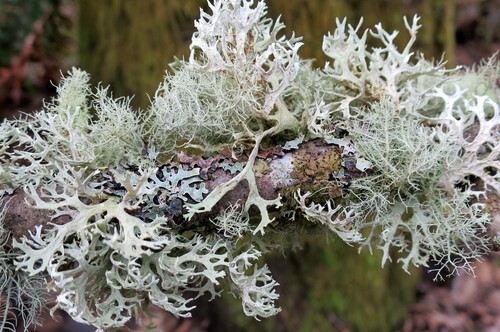Lichenized fungi or lichen are complex organisms formed from an association of mutualistic symbiosis between one fungus is seaweed.
Even though they are not plants, they are commonly studied by botanists. According to the International Code of Botanical Nomenclature, the term "lichens" is in disuse, being the most correct nowadays to designate these organisms the term “lichenized fungi”.
Many of these fungi and algae that form the lichenized fungi they do not survive isolated in the same habitat.
most of the body of the lichenized fungus is formed by the fungus, called in this association the mycobiont organism, they generally belong to the Phylum Ascomycota, with only a small portion of 2% belonging to the PhylumBasidiomycota.
The alga is the organism that carries out the photosynthesis, being called photobionte, they are usually chlorophyceous or cyanobacteria.
As fungi do not synthesize their own food, symbiosis guarantees carbohydrates, produced by photobionts during photosynthesis, to your nutrition.
Algae, on the other hand, gain protection from the fungus and a stable environment so that it can develop more efficiently than if it had it alone.
Lichenized fungi can even inhabit places considered inhospitable such as rocks. They are capable of producing substances that cause weathering in rocks, thus starting the process of forming a new soil.
Index
- Types of lichens
- Lichen reproduction
- Importance of lichens
- Are lichen and mycorrhizae the same thing?
- Curiosities
Types of lichens
The classification of lichens is based on the morphology of mycobionts and, for that, characteristics of the talus and reproductive organs are used.
Approximately 20 thousand species of lichen have already been classified and each one of them has a different fungus. The scientific name of the lichenized fungus species is the scientific name of the fungus.
It is estimated that 20% of the fungi we know of are involved in a symbiotic association with an alga.
Unlike fungi, the same species of alga can be part of several different lichenized fungi.
- crusty: they are strongly adhered to the substrate, the stalk is usually round in the shape of a crust.

- Foliosas or Foliaceous: they have leaf-shaped stalks.

- Fruity or fruity: the stalks have an erect position, in the shape of a small bush.

- Free Online Inclusive Education Course
- Free Online Toy Library and Learning Course
- Free Online Math Games Course in Early Childhood Education
- Free Online Pedagogical Cultural Workshops Course
Lichen reproduction
Lichenized fungi do not show sexual reproduction and asexual reproduction can occur in various ways:
- by spores formed by the fungus that germinate when they encounter an algae;
- By fragmentation of the stalk;
- By propagules that have both algae cells and fungal hyphae;
- Per Isides that are stem projections.
Individuals can also reproduce individually, algae reproduce vegetatively and fungi through spores.
Importance of lichens
Bioindicators
Lichenized fungi are sensitive to air pollution, their absence indicates an environment with excessive environmental pollution.
Ecological succession
The weathering action caused by substances secreted by lichenized fungi form new soils allowing colonization by other living beings.
nitrogen fixation
Some algae, such as cyanobacteria, produce ammonia from nitrogen gas and incorporate these molecules into organic substances, allowing them to be metabolized by other living beings.
Cardinal point indicators
Lichenized fungi are always facing the rising sun.
Are lichen and mycorrhizae the same thing?
This is a common question and the answer is that they are not the same thing. Although they are also a symbiotic relationship, the mycorrhizae they are formed for the association of fungi and plant roots.
Curiosities
The fungi involved in this association are totally dependent on the alga to survive, whereas the algae can have free life, regardless of the association with the fungus.
Although most lichenized fungi are a relationship of mutualism between the two, in some cases the fungus can parasitize the alga, trapping it in the association.

See too:
- Ecological relationships of living beings
- Intra and interspecific interactions
The password has been sent to your email.
